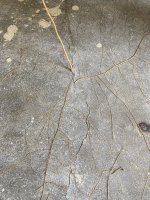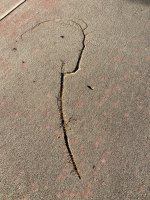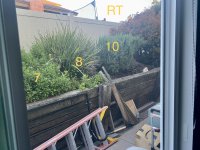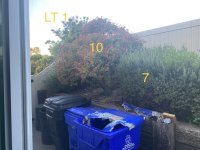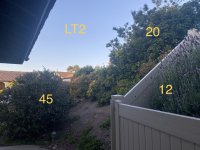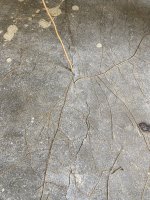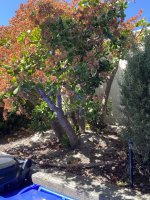Hello, could anyone take a guess as to what the plant of this root looks like. We found it between a floating floor padding and the concrete foundation. There is a 3 foot sidewalk between the wall and any plants/ weeds/ trees. It must be growing under the slab and coming up through the tiny 1-2mm cracks in the foundation. Any help you be appreciated.
You are using an out of date browser. It may not display this or other websites correctly.
You should upgrade or use an alternative browser.
You should upgrade or use an alternative browser.
Please help ID the plant of this root
- Thread starter Davester00
- Start date
Greetings, welcome to the Forums.
How intriguing. Beyond the basic supposition that it is something perennial, and possibly woody. I really couldn't hazard a guess.
You could try planting fresh roots in potting soil to see if anything sprouts. Most plants do not readily resprout from roots, but some do.
How intriguing. Beyond the basic supposition that it is something perennial, and possibly woody. I really couldn't hazard a guess.
You could try planting fresh roots in potting soil to see if anything sprouts. Most plants do not readily resprout from roots, but some do.
- Joined
- Feb 2, 2014
- Messages
- 11,484
- Reaction score
- 5,590
- Location
- La Porte Texas
- Hardiness Zone
- 8b
- Country

Any trees nearby? This is not good
5 years ago we removed a 50’ pine tree that was about 50’ away. The pine tree was cut down and the stump was ground to 1 foot below ground level. At the time the pine tree was alive we did not have any root growth as shown in the pictures.Any trees nearby? This is not good
I’ll take a picture of the closest plants/ trees to this room and post them soon.
Here are pictures of the bushes trees. The distance in marked in feet. Pic 1 right side , 2 left side and 3 is far left side . Pictures are in relation to window which is on the wall of the room closes to anything green
Attachments
- Joined
- Feb 2, 2014
- Messages
- 11,484
- Reaction score
- 5,590
- Location
- La Porte Texas
- Hardiness Zone
- 8b
- Country

I don't know what any of these plants are but none seem to be a threat to the buildings foundation except for the possibility of the small tree in picture 2. Do you know the construction of the building. Is it a poured slab or a pier and beam construction? Is it a sandwich construction with lightweight cement layered on top of the foundation? If this is a poured slab this root could be of major concern. There are not supposed to be any voids in the concrete to allow roots to penetrate and as a tree grows so do its roots grow in size. This could possibly lead to a failure of the slab. Usually root damage to a slab is caused by the root growing underneath the slab and lifting it up and cracking it. If this is a pier and beam constructed it is not a large a concern as the roots would grow up the side instead of through the concrete. On a sandwich construction a thin layer of about 1-2 inches thick of lightweight cement is used as a fairing to make the surface more amenable to cosmetic applications. I doubt this is a sandwich constructed building.
Please confirm which small tree. Is it the one marked “10” in the second picture ?I don't know what any of these plants are but none seem to be a threat to the buildings foundation except for the possibility of the small tree in picture 2. Do you know the construction of the building. Is it a poured slab or a pier and beam construction? Is it a sandwich construction with lightweight cement layered on top of the foundation? If this is a poured slab this root could be of major concern. There are not supposed to be any voids in the concrete to allow roots to penetrate and as a tree grows so do its roots grow in size. This could possibly lead to a failure of the slab. Usually root damage to a slab is caused by the root growing underneath the slab and lifting it up and cracking it. If this is a pier and beam constructed it is not a large a concern as the roots would grow up the side instead of through the concrete. On a sandwich construction a thin layer of about 1-2 inches thick of lightweight cement is used as a fairing to make the surface more amenable to cosmetic applications. I doubt this is a sandwich constructed building.
Home was built in the early 80s. I will confirm with my general contractor to get his thoughts on the foundation. My guess is that it is a sandwich construction foundation.
- Joined
- Feb 2, 2014
- Messages
- 11,484
- Reaction score
- 5,590
- Location
- La Porte Texas
- Hardiness Zone
- 8b
- Country

Yes, that is the tree. I had another thought. Is this root close to a penetration in the foundation such as would be in a restroom or other drainage or pipes going through the concrete? Have you tried to follow the root back to where it comes into the room?Please confirm which small tree. Is it the one marked “10” in the second picture ?
Home was built in the early 80s. I will confirm with my general contractor to get his thoughts on the foundation. My guess is that it is a sandwich construction foundation.
Root is coming through this crack in more than one spot. See how I lift the root up and the root is emerging from the crack.Yes, that is the tree. I had another thought. Is this root close to a penetration in the foundation such as would be in a restroom or other drainage or pipes going through the concrete? Have you tried to follow the root back to where it comes into the room?
Attachments
Last edited:
- Joined
- Feb 2, 2014
- Messages
- 11,484
- Reaction score
- 5,590
- Location
- La Porte Texas
- Hardiness Zone
- 8b
- Country

This is just a guess but it appears that this top layer of aggregate is thin and more than likely the foundation is of some type of sandwich construction. If so, I would guess that the foundation is a pier and beam construction which is good news. Pier and beam construction consists of deeper cement usually 4-6 inches wide where interior walls, exterior walls and load bearing walls are located. Everything in between these areas are normally poured cement usually no more than 4 inches thick and have little bearing on the actual integrity of the structure. But, to make sure, talk to someone who knows how the structure was constructed. You can find this out from the city by looking at their stored blueprints or from whoever built the structure.Root is coming through this crack in more than one spot. See how I lift the root up and it is coming from the crack. I’m sure it found more than one spot to come up.
It has been confirmed from one of the original owners (long time area realtor of our development). Foundation is slab on grade.This is just a guess but it appears that this top layer of aggregate is thin and more than likely the foundation is of some type of sandwich construction. If so, I would guess that the foundation is a pier and beam construction which is good news. Pier and beam construction consists of deeper cement usually 4-6 inches wide where interior walls, exterior walls and load bearing walls are located. Everything in between these areas are normally poured cement usually no more than 4 inches thick and have little bearing on the actual integrity of the structure. But, to make sure, talk to someone who knows how the structure was constructed. You can find this out from the city by looking at their stored blueprints or from whoever built the structure.
That is a Jade Plant (Crassula ovata). It could not pose any threat to the house's foundation.
Only large plants, for the most part trees, might produce roots thick enough to do damage.
For the record, the plants pictured in Post #5 are
First Photo.
7. African Daisy or Freeway Daisy (Dimorphotheca fruticosa, formerly Osteospermum fruticosum)
8. Fortnight Iris (Dietes sp.), post a close-up picture with flowers for a specific identification.
10. Rosemary (Salvia rosmarinus, formerly Rosmarinus officinalis)
Second Photo.
10. Jade Plant (Crassula ovata)
7. more African Daisy and Rosemary
Third Photo.
45. Possibly a native Rhus, post a sharp, closer picture of leaves and flowers and fruits if any.
20. Cape-honeysuckle (Tecomaria capensis)
12. Toothed Lavender (Lavandula dentata)
Only large plants, for the most part trees, might produce roots thick enough to do damage.
For the record, the plants pictured in Post #5 are
First Photo.
7. African Daisy or Freeway Daisy (Dimorphotheca fruticosa, formerly Osteospermum fruticosum)
8. Fortnight Iris (Dietes sp.), post a close-up picture with flowers for a specific identification.
10. Rosemary (Salvia rosmarinus, formerly Rosmarinus officinalis)
Second Photo.
10. Jade Plant (Crassula ovata)
7. more African Daisy and Rosemary
Third Photo.
45. Possibly a native Rhus, post a sharp, closer picture of leaves and flowers and fruits if any.
20. Cape-honeysuckle (Tecomaria capensis)
12. Toothed Lavender (Lavandula dentata)
Last edited:
- Joined
- Feb 2, 2014
- Messages
- 11,484
- Reaction score
- 5,590
- Location
- La Porte Texas
- Hardiness Zone
- 8b
- Country

If this is true then the only explanation is that the slab is compromised, either by a poorly poured slab which left voids, by roots growing up through penetrations through the slab or by roots growing up the exterior of the slab and growing under the top cosmetic layer. Hopefully it is the latter. To make sure that there is a top cosmetic layer of aggregate just get a cold chisel and chisel away a small portion. Are you sure there are no large trees anywhere fairly close. No matter what, I would get a certified inspector to come take a lookIt has been confirmed from one of the original owners (long time area realtor of our development). Foundation is slab on grade.
That is a Jade Plant (Crassula ovata). It could not pose any threat to the house's foundation.
Only large plants, for the most part trees, might produce roots thick enough to do damage
Thank your for your very thorough identification of plants. It is greatly appreciated!That is a Jade Plant (Crassula ovata). It could not pose any threat to the house's foundation.
Only large plants, for the most part trees, might produce roots thick enough to do damage.
For the record, the plants pictured in Post #5 are
First Photo.
7. African Daisy or Freeway Daisy (Dimorphotheca fruticosa, formerly Osteospermum fruticosum)
8. Fortnight Iris (Dietes sp.), post a close-up picture with flowers for a specific identification.
10. Rosemary (Salvia rosmarinus, formerly Rosmarinus officinalis)
Second Photo.
10. Jade Plant (Crassula ovata)
7. more African Daisy and Rosemary
Third Photo.
45. Possibly a native Rhus, post a sharp, closer picture of leaves and flowers and fruits if any.
20. Cape-honeysuckle (Tecomaria capensis)
12. Toothed Lavender (Lavandula dentata)
Ask a Question
Want to reply to this thread or ask your own question?
You'll need to choose a username for the site, which only take a couple of moments. After that, you can post your question and our members will help you out.
Similar Threads
Forum statistics
Latest Threads
-
I Might Have Messed Up Again
- Started by big rockpile
-
The Japanese Turnip
- Started by Meadowlark
-
Growing melons and winter squash vertically, netting.
- Started by YumYum
-
Suggestion For Covered Pergola Outdoor Kitchen?
- Started by Ambrose A. Dale
-
Sterling Silver Brunnera
- Started by PlntFnNan
-
More Air
- Started by big rockpile
-
Greenhouse footing
- Started by Leif
-
Action or wiggle hoe for weeding
- Started by Donatello
-
Gardening Product to help with back pain
- Started by tiana

